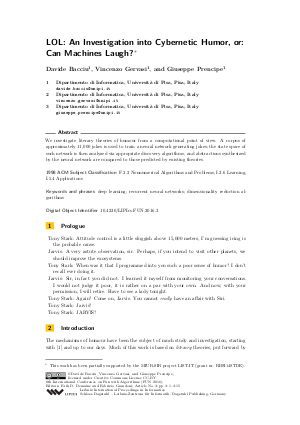LOL: An Investigation into Cybernetic Humor, or: Can Machines Laugh?
Authors Davide Bacciu, Vincenzo Gervasi, Giuseppe Prencipe
-
Part of:
Volume:
8th International Conference on Fun with Algorithms (FUN 2016)
Part of: Series: Leibniz International Proceedings in Informatics (LIPIcs)
Part of: Conference: International Conference on Fun with Algorithms (FUN) - License:
 Creative Commons Attribution 3.0 Unported license
Creative Commons Attribution 3.0 Unported license
- Publication Date: 2016-06-02
File

PDF
LIPIcs.FUN.2016.3.pdf
- Filesize: 1.39 MB
- 15 pages
Document Identifiers
Subject Classification
Keywords
- deep learning
- recurrent neural networks
- dimensionality reduction algorithms
Metrics
- Access Statistics
-
Total Accesses (updated on a weekly basis)
0PDF Downloads0Metadata Views
Abstract
The mechanisms of humour have been the subject of much study and investigation, starting with and up to our days. Much of this work is based on literary theories, put forward by some of the most eminent philosophers and thinkers of all times, or medical theories, investigating the impact of humor on brain activity or behaviour. Recent functional neuroimaging studies, for instance, have investigated the process of comprehending and appreciating humor by examining functional activity in distinctive regions of brains stimulated by joke corpora. Yet, there is precious little work on the computational side, possibly due to the less hilarious nature of computer scientists as compared to men of letters and sawbones. In this paper, we set to investigate whether literary theories of humour can stand the test of algorithmic laughter. Or, in other words, we ask ourselves the vexed question: Can machines laugh? We attempt to answer that question by testing whether an algorithm - namely, a neural network - can "understand" humour, and in particular whether it is possible to automatically identify abstractions that are predicted to be relevant by established literary theories about the mechanisms of humor. Notice that we do not focus here on distinguishing humorous from serious statements - a feat that is clearly way beyond the capabilities of the average human voter, not to mention the average machine - but rather on identifying the underlying mechanisms and triggers that are postulated to exist by literary theories, by verifying if similar mechanisms can be learned by machines.
Cite As Get BibTex
Davide Bacciu, Vincenzo Gervasi, and Giuseppe Prencipe. LOL: An Investigation into Cybernetic Humor, or: Can Machines Laugh?. In 8th International Conference on Fun with Algorithms (FUN 2016). Leibniz International Proceedings in Informatics (LIPIcs), Volume 49, pp. 3:1-3:15, Schloss Dagstuhl – Leibniz-Zentrum für Informatik (2016)
https://doi.org/10.4230/LIPIcs.FUN.2016.3
BibTex
@InProceedings{bacciu_et_al:LIPIcs.FUN.2016.3,
author = {Bacciu, Davide and Gervasi, Vincenzo and Prencipe, Giuseppe},
title = {{LOL: An Investigation into Cybernetic Humor, or: Can Machines Laugh?}},
booktitle = {8th International Conference on Fun with Algorithms (FUN 2016)},
pages = {3:1--3:15},
series = {Leibniz International Proceedings in Informatics (LIPIcs)},
ISBN = {978-3-95977-005-7},
ISSN = {1868-8969},
year = {2016},
volume = {49},
editor = {Demaine, Erik D. and Grandoni, Fabrizio},
publisher = {Schloss Dagstuhl -- Leibniz-Zentrum f{\"u}r Informatik},
address = {Dagstuhl, Germany},
URL = {https://drops.dagstuhl.de/entities/document/10.4230/LIPIcs.FUN.2016.3},
URN = {urn:nbn:de:0030-drops-58823},
doi = {10.4230/LIPIcs.FUN.2016.3},
annote = {Keywords: deep learning, recurrent neural networks, dimensionality reduction algorithms}
}
Author Details
References
-
Aristotle. Poetics, volume two: On Comedy. IV century BCE. Last surviving copy reportedly lost in the fire of the Abbey’s Library in 1327, according to [6].

-
Salvatore Attardo. Linguistic Theories of Humor. De Gruyter Mouton, Berlin, 1994.

-
Yoshua Bengio, Patrice Simard, and Paolo Frasconi. Learning long-term dependencies with gradient descent is difficult. Neural Networks, IEEE Transactions on, 5(2):157-166, 1994.

-
Yu-Chen Chan. Emotional structure of jokes: A corpus-based investigation. Bio-medical materials and engineering, 24(6):3083-3090, 2014.

-
Yu-Chen Chan and Joseph P Lavallee. Temporo-parietal and fronto-parietal lobe contributions to theory of mind and executive control: an fMRI study of verbal jokes. Frontiers in psychology, 6, 2015.

-
Umberto Eco. Il nome della rosa. Bompiani, 1980.

-
Paolo Frasconi, Marco Gori, and Alessandro Sperduti. A general framework for adaptive processing of data structures. Neural Networks, IEEE Transactions on, 9(5):768-786, 1998.

-
Lisa Friedland and James Allan. Joke retrieval: Recognizing the same joke told differently. In Proceedings of the 17th ACM Conference on Information and Knowledge Management, CIKM'08, pages 883-892, New York, NY, USA, 2008. ACM.

- Alex Graves. Generating sequences with recurrent neural networks. CoRR, abs/1308.0850, 2013. URL: http://arxiv.org/abs/1308.0850.
-
Alex Graves and Jürgen Schmidhuber. Framewise phoneme classification with bidirectional lstm and other neural network architectures. Neural Networks, 18(5):602-610, 2005.

-
Ulrich Günther. What is in a laugh? Humour, jokes and laughter in the conversational corpus of the BNC. PhD thesis, Albert-Ludwigs-Universität, Freiburg, 2003.

-
Sepp Hochreiter and Jürgen Schmidhuber. Long short-term memory. Neural computation, 9(8):1735-1780, 1997.

-
Laurens Van Der Maaten. Accelerating t-sne using tree-based algorithms. The Journal of Machine Learning Research, 15(1):3221-3245, 2014.

-
Laurens Van der Maaten and Geoffrey Hinton. Visualizing data using t-sne. Journal of Machine Learning Research, 9(2579-2605):85, 2008.

-
Wendel Wallach and Colin Allen. Moral Machines: Teaching Robots Right from Wrong. Oxford University Press, November 2008.

